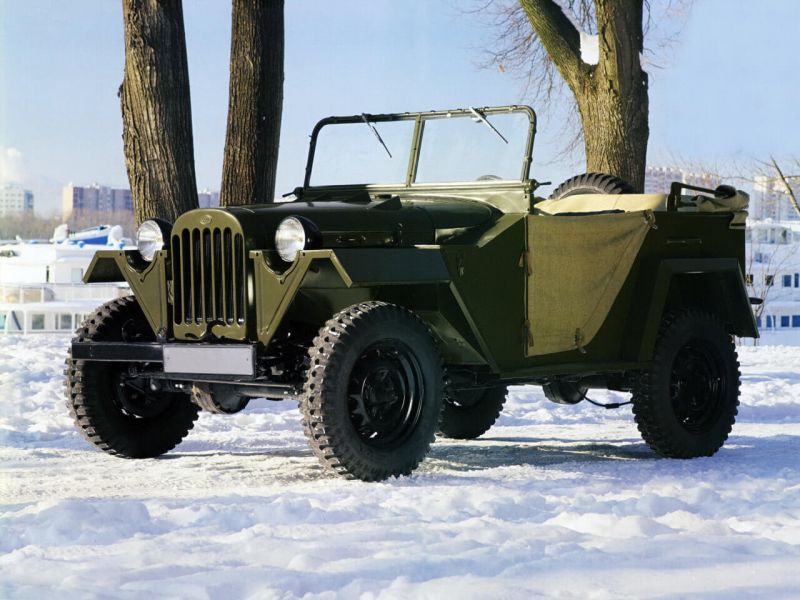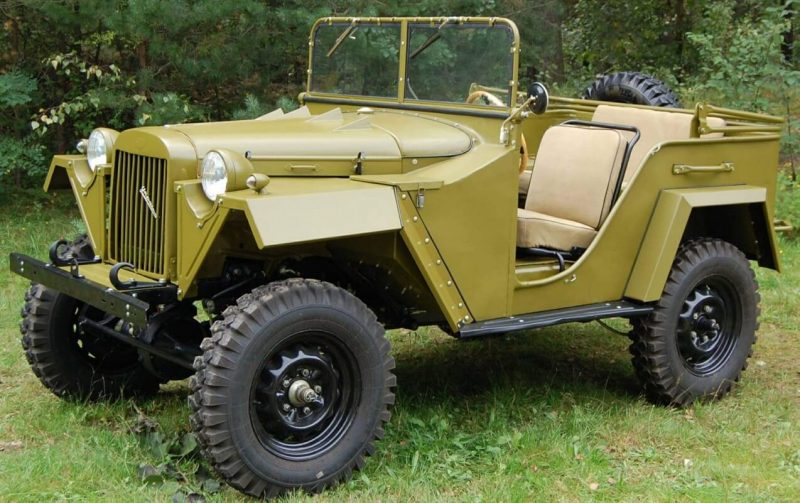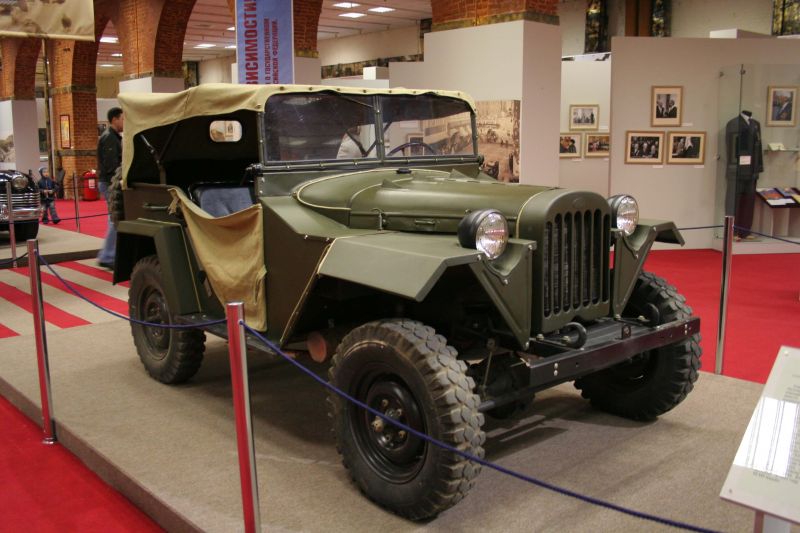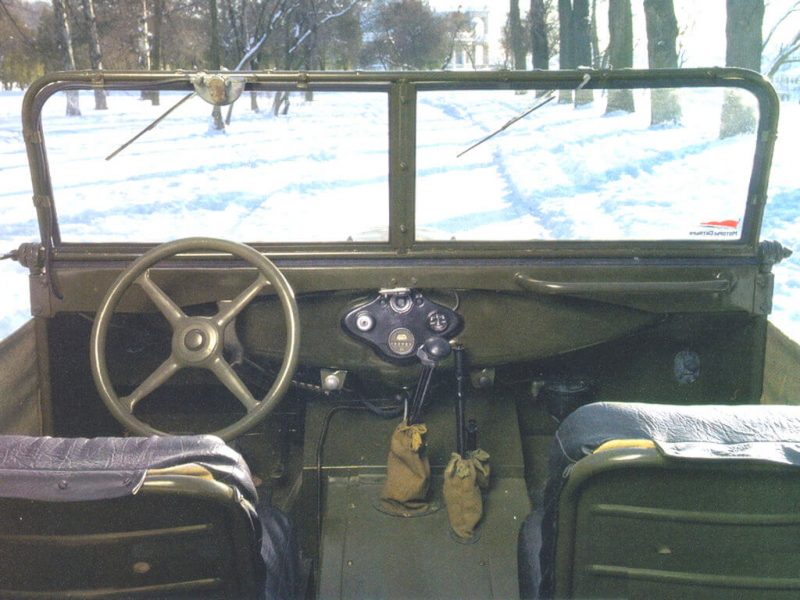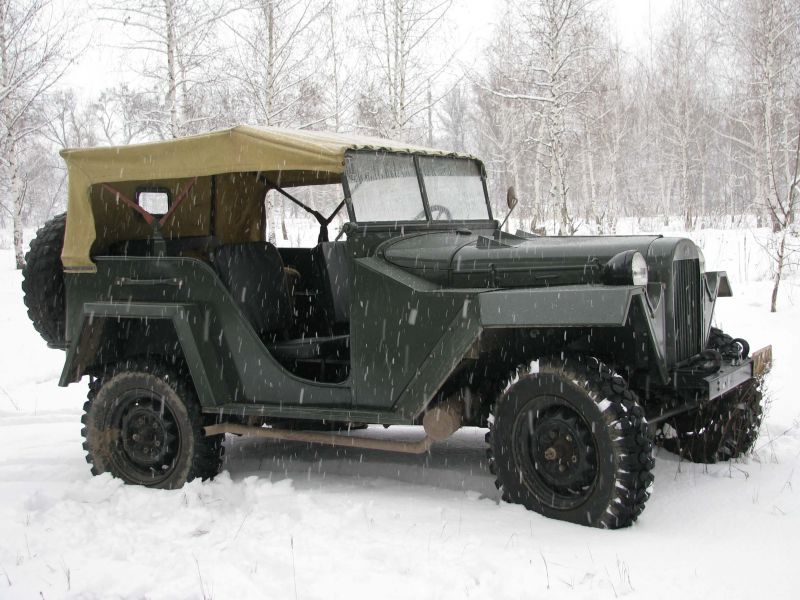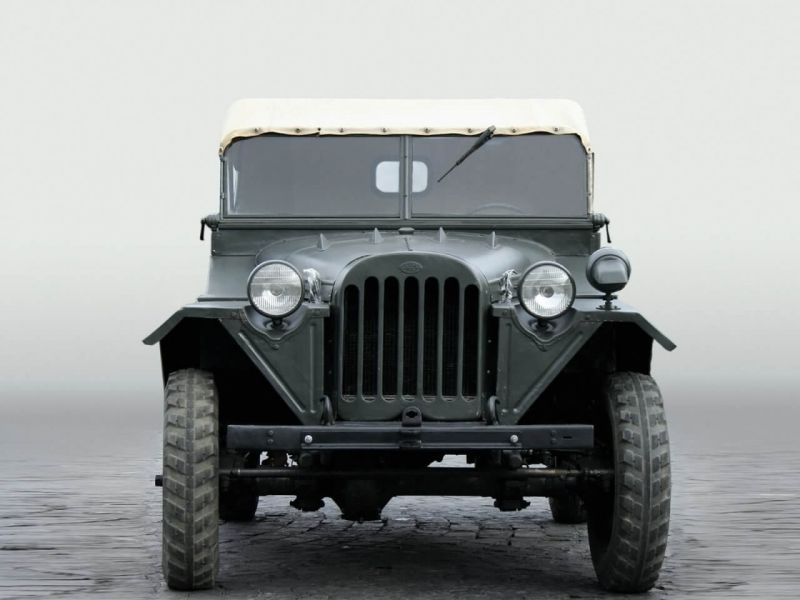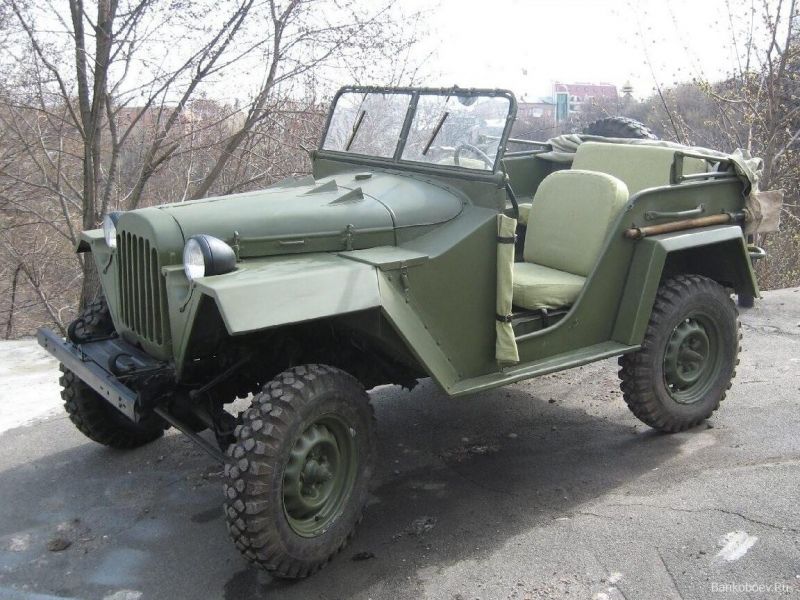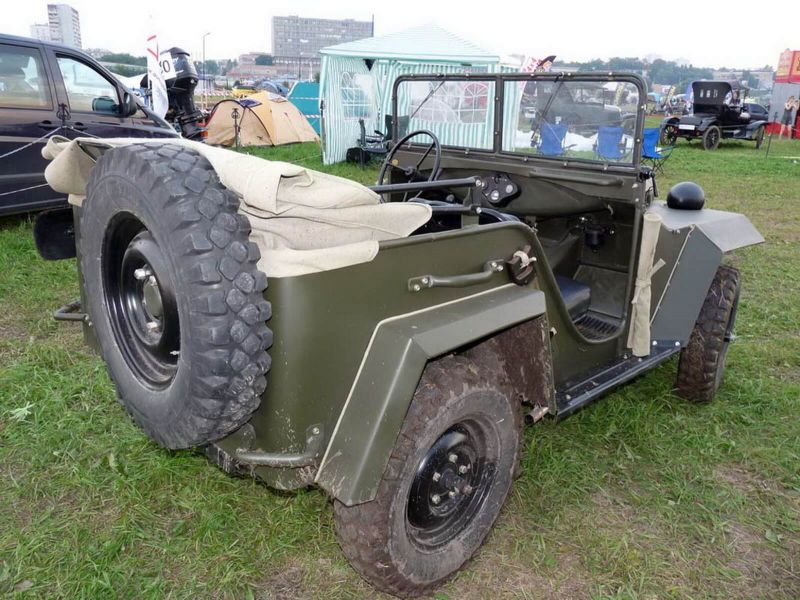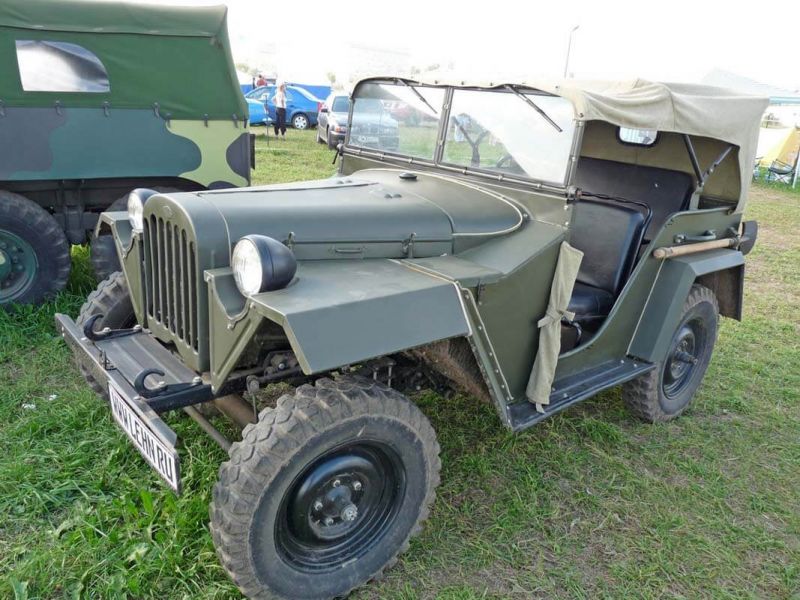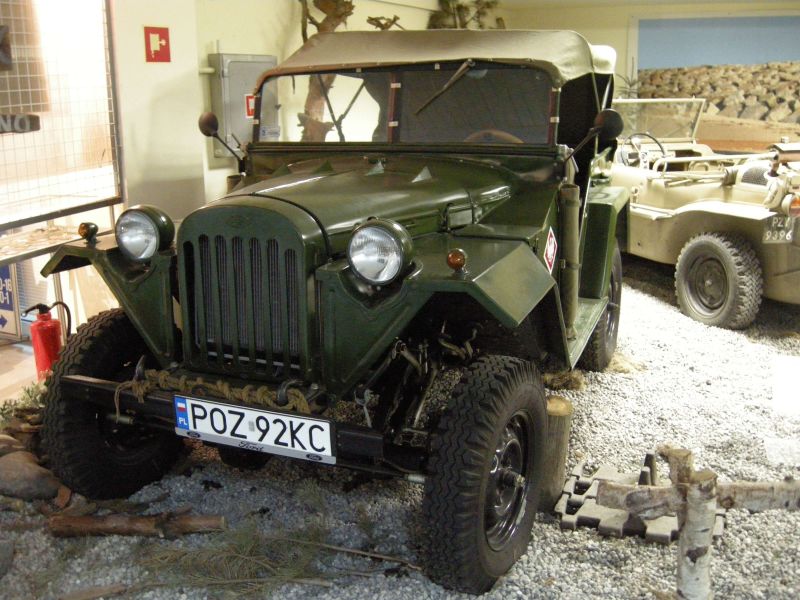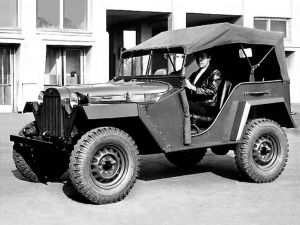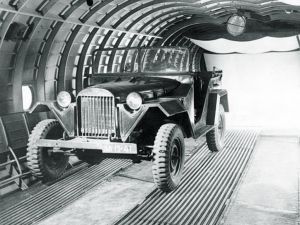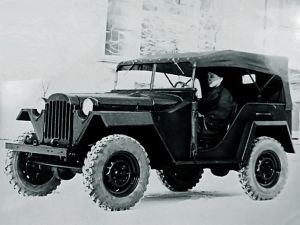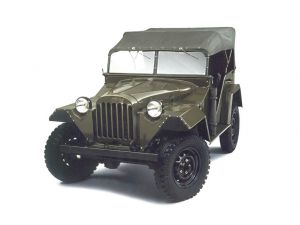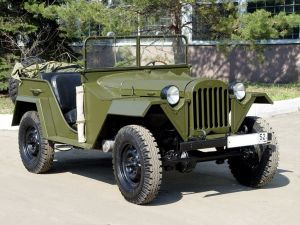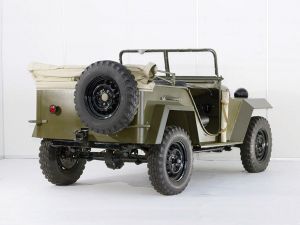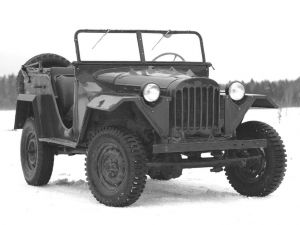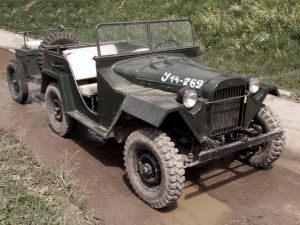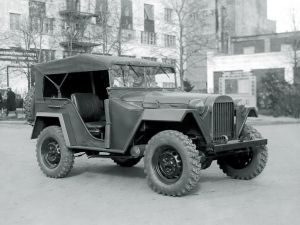GAZ-67
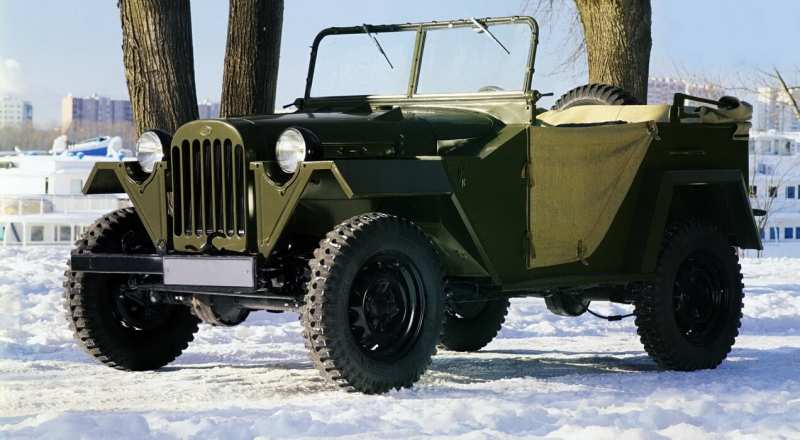
In 1939, when the Soviet-Finnish war was in full swing, there was a great need to create a light and maximally mobile car-truck. And this can be easily explained, because the most important part of the fighting was deployed during the harsh winter and real impassability. This car was needed to maintain, in the most important way, the average composition of the command of the Soviet army.
It was also used for transportation and towing of light artillery systems. From the very beginning, an all-terrain vehicle GAZ-61 was created, but it could not cope with all the goals set by the army command. Following numerous upgrades, almost perfect version of the GAZ-67B was created. The whole model range is GAZ.
Model development
The 67th Lawn is a Russian military all-wheel drive passenger car with a simplified open body, which has cut-outs instead of doors. The model was created under the command of a good designer V.A. Grachev on the platform of GAZ-M1 vehicles. Since the Lawn 61st for the required purposes was expensive and difficult, and besides, the power plant was only mastered by industry, the Russian army needed a simplified “soldier’s” vehicle.
Therefore, the Malyshev People’s Commissariat issued its order in 1941. Before NATI, together with the Gorky Automobile Plant, the task was to make a small cross-country vehicle. They said about the necessary load of the car, which was equal to 400 kg, and the mileage to write-off was five thousand kilometers. Taking into account all the factors, there was also an agreement that the wheel gauge and length should have been similar to the Bantam car.
The essence of this is that the new lawn was planned to be operated as an airborne lawn, and it was planned to be placed in the cargo department of the transport aircraft PS-84 (Li-2). Therefore, the designers together with Grachev, engineer Wasserman and technician Kuzin began to work on the model.
In addition to these specialists, other designers were sometimes involved in the development, such as Komarevsky (who was engaged in the design of the body) and Prosvirin (who was engaged in steering trapeze). Design of a new off-road vehicle, which received the index Gaz-64-416, began on February 3, 1941. After 9 days, the debut drawings got into the workshops. The design was developed within 51 days.
The light off-road vehicle GAZ-67 was designed in a very short period of time – 51 days, which was quite a short period at that time.
As the basis of the new model, the bittermen took units and units of the 61st car, which had a fairly high reliability. It is worth mentioning that due to one of the tasks, the track of the car was significantly reduced, which affected the groundless reform of bridges. The 64th cross-country vehicle had an open, simple doorless body with transverse seats.
The vehicle was designed to transport 4-5 passengers. The front glass could be tilted forward, and the top was tarpaulin. The frame construction had closed spars and was retailed with high strength characteristics. There was a rigid bumper in front and a towing mechanism in the back.
The engine was a gasoline four-cylinder 54-horsepower unit, and the transmission was a 4-speed gearbox from a GAZ-MM truck. The rear axle, together with the front drive axle, dispenser, wheels, brakes and steering system were standardized with the all-wheel drive car GAZ-61-40. A new radiator was developed from the GAZ-AAA car. The front suspension was also distinguished by a unique mechanism with four quarter-elliptic leaf springs.
In the spring, March 4th, they started to assemble the car. After 13 days the bodywork was completed, and 8 days later GAZ-67 was painted. The new all-terrain vehicle was taken out of the factory by Grachev himself and not by anybody there, the same day when it was painted. In the period from April 15 to 27, the Lawn passed short military tests, after which it was put into mass production.
Already in April 1941 the model was presented to the military. Following their approval, serial production started in August of the same year. The vehicle could be quickly delivered for production, because a considerable number of vehicles already mastered by the company were used in the construction moments. This was the main reason for the victory of the Gorky enterprise in the competition.
For the Red Army, before the end of the same year, 41 years, was delivered 601 copies, which perfectly withstood the trials in wartime. The RKKF did not have a car of the similarity to the 64th model, only a little later, the supplies of American cars, with which the Gorky Automobile Plant could compete well, were started under the Lend-Lease. Before GAZ-64 was adopted, small guns could be transported on horse-drawn traction, and GAZ-A and Emka served for command and staff vehicles.
Appearance
The body, which was created by Komarevsky, was open, universal and had three seats for four people. Also, the shelves installed on the wings at the back and side could accommodate a couple of people. Nearby were placed small arms and ammunition (up to 45-mm shells) along with special equipment. In order to get out of the car freely and jerkly, the body was decided to make without doors, there were front apertures, which in bad weather could be covered with tarpaulin aprons.
The presence of tarpaulin awnings with a simple shape without sides implied its installation on one arc (later – on two). The windshield was in a strictly vertical design, so that the sun glare would not reflect upwards. It could be tilted forward and fixed horizontally.
The wiper was vacuum driven and installed only for the driver. The windscreen wiper of the second part of the windscreen received a manual lever. The front windshield windshield wipers, together with the rear-view mirrors, decided not to install the windshield wipers. All body surfaces were flat or flat, or had box-shaped shapes bent in one plane, so it wasn’t so difficult to make the body.
The ends of the body panels were surrounded by pipes. At all joints of the joints, spot welding was used, only occasionally – arc welding. In order to decorate the front part of the car used parts from GAZ-AAA, the radiator shell was with the logo at the top. The hood cover, the main gasoline tank of 43 liters in front of the windshield together with the dashboard – all this was from the AA model.
The front bumper was carried forward by 4 cm, which made it possible to remove one of the defects of the 64th Lawn, when they quickly appeared during the military exploitation of cracks in some overstretched areas of the frame. Wing reamers were also introduced along with the new torpedo. The steps were installed flush with the wings.
Design features
In order to improve the aerodynamic component of the space under the hood, it was proposed by the designer Komarevsky to make fume slots in the aft part of the hood covers. Although many people thought that they were made for heating the windshield. Due to the fact that the model was shortened by comparing it to the 61st Lawn (by 755 millimeters), the platform of the machine made it possible to discard the rear intermediate drive shaft.
The front-mounted open PTO shaft acquired the joints on 51st Lawn needle roller bearings. In order to increase the front angle of entry to 75 degrees and facilitate the passage of vertical walls (up to half a meter), installed in front of the bridge hung on 4 quarters of elliptical springs. It would not be superfluous to mention that this was a proposal by Grachev himself.
But such a suspension characterized itself as a lack of reliability and rapid failure of the sheets because of their inexpedient and abrupt loading and minimal lateral rigidity. In order to increase the stability of linear motion in the joints of all the springs installed properly protected threaded pins and bushings from the 11th model, which are durable.
In order to avoid resonance “galloping” with such a small base and selected suspension, strong hydraulic shock absorbers were required. The design staff decided to install 4 shock absorbers (pair per axle), which have a one-way action. They turned out to be unreliable and ineffective. Availability of energy-intensive and workable double-sided shock absorbers was under study.
In the 64th Lawn, the rear axle, which was used from GAZ-M1, turned out to be not completely reliable for the SUV, and during the movement at the 1st or the rear speeds there were breakdowns of gears. Therefore, it was decided to introduce a locking mechanism on the 67th model, which provided the opportunity to include the 1st or the rear speed only when the drive is operating on both axles.
After all, for those times, the constantly switched on drive on all wheels along with the self-locking interaxle differential were a miracle. In addition, before mastering these models, the company had no experience with these designs at all. The vehicle received a reinforced frame, spars, which received a full covered profile and received kerchiefs with lining, auxiliary rear cross member.
The rear springs were carried out over the bridge covers, which made it possible to make more ground clearance underneath them. They were based on the frame and could not do without cantilever brackets. Thanks to the enlarged spring track, the rear mounted anti-roll bar was no longer needed. As the efficiency was impaired and there was a constant lack of shock absorbers, they decided to remove the 2nd pair from the stern.
The off-road vehicle was able to strengthen, for example, the front suspension parts, crankcase and steering unit tips, rudder bipods, spare parts for the rear body wall and the towing device. An auxiliary gasoline tank of 33 liters was placed under the driver’s seat. It was synchronized with the power supply system by means of a three-way crane from the AAA gasoline vehicle. The battery was moved to a specialized department, which was located behind the front right wing.
The rudder control device was retailed from the 61st car by a transverse steering rod, which passed in front of the beam of the front axle and was straight, without bends, which dramatically increased its rigidity. But the front blows made it more unprotected. The layout environment and frame construction made the rudder column tilt non-standardly at a considerable angle (10.27 degrees), but this did not interfere with steering in any way.
Brake mechanism
It was presented on four wheels in a similar way as on GAZ-11-73 – by cable. However, there was still a rigid transfer shaft, which was driven by the same pedal and hand lever. To simplify the design, we decided not to use equalizers.
Power unit
It was powered by a 4-cylinder engine that produced 54 horsepower and ran on gasoline. Carburetor was installed K-21. The silencer was located at GAZ-M1, where there were transformed pipes. Ignition distributor (IM-91) was installed from “Emki”, where there were open conductive plates together with a powerful six-row radiator.
Transmission
The power unit and wheels were synchronized by a mechanical 4-speed gearbox from a GAZ-MM truck.
Completion of 1944 allowed to modernize the army vehicle, which received the index GAZ-67B. The model worked on the same engine and with the same 4-speed switching box, but a new carburetor, an ignition distributor with a gasoline filter, was introduced. The front axle was reinforced with new needle roller bearings and the drive shaft with suspension was improved.
The 1948 year allowed replacing the old grille with a stamped facing, where there were seven air intake slots, which were located in a vertical design. There was a certain American style of “Willis-MV”. Three years later, hydraulic shock absorbers of double functioning were introduced. In 1953, the shape of the ventilation holes on the hood was changed.
Production of the off-road vehicle continued for 9 years, which made it the most famous postwar and multi-purpose model. In the year when they started to actively develop the Lawn-69, the GAZ-67B model stopped producing. It will be extremely difficult to buy a Soviet off-road all-wheel drive vehicle GAZ-67. Many of the surviving models are being preserved by museums and private collectors.
The pros and cons
Pluses cars
- High-quality and reliable body metal;
- Not bad power unit;
- Solid height of road clearance;
- Good cross-country ability of the car;
- Full drive system;
- Possibility of transportation of small trailers;
- There are no doors that considerably facilitates fast landing/drop-off of passengers;
- On the car in wartime could jump on the move soldiers that did not require a complete stop car;
- It is possible to throw a tarpaulin canvas over the car;
- Small size;
- There are windscreen wipers for the windscreen;
- Later modifications included hydraulic shock absorbers, which increased comfort.
Cons of a car
- There are no hydraulic power units in the steering and braking systems;
- No seat belts;
- Steering wheel and seats are not adjustable;
- No luggage compartment;
- Simple Spartan interior with minimum comfort;
- In a cool time, is in the car extremely bad, does not save even a tarpaulin awning;
- Inside there is not much free space.
We sum up
Summing up the results of this car – GAZ-67, I would like to say briefly – they were done well and simply, which was their trump card. The car was not demanding and fastidious. Its small overall characteristics allowed to drive it almost everywhere. Nor was she afraid of off-roads, which is what it was designed for.
In summer, the car had almost no problems, but in the cold season, not even saved the tent. Personnel of the Soviet army with dignity appreciated this model, because it is with her they often had to work.
The vehicle could take up to two small cannons on a trailer. The model was also used as a vehicle to transport personnel. The high ground clearance allowed it to be afraid of almost no difficulties that could arise on the road. There is no doubt that GAZ-67 went down in the history of the vehicles of the Union of Soviet Socialist Republics.
We advise you to read the article: GAZ – history of car production
GAS-67 photo
Test drive


